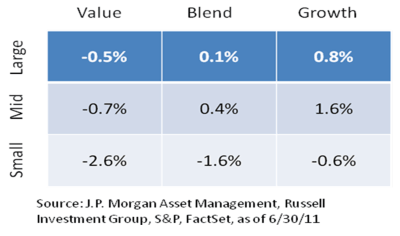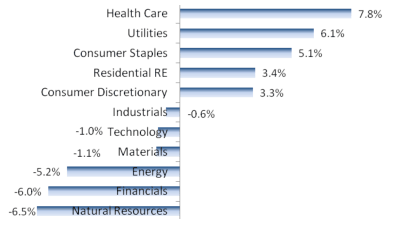Greek Salad
Global capital markets offered a mix of events in the second quarter that stopped the stock market rally cold before rallying impressively in late June. After markets were tossed in March by Middle East and African political uncertainty followed by the supply chain – disrupting Japanese earthquake and tsunami, they were drenched by April’s severe weather in broad parts of the US. Then the sequel to last year’s Greek crisis entered the mix in May as the beleaguered southern European country struggles with its high debt and weak economy. Finally, US politicians began a long battle to narrow a fast growing deficit before they extend the Federal government’s debt ceiling and thus (hopefully) avoid a technical default. All these events contribute to uncertainty and make for dramatic negative news headlines. For the second quarter, the broad US equity market, as measured by the S&P 500 rose 0.1% outpaced by the US bond market’s 2.3% rise, (Barclays Capital US Aggregate Index). All major international stock markets except Germany and Japan dropped in local currency terms in 2Q; only the German, Swiss, and Japanese markets were up in U.S. $ terms.
Weaker Fundamentals. Economic fundamentals turned mixed in recent months but continue to point to a sustained, albeit subdued, U.S. economic recovery. Concern grew that higher energy prices and global uncertainties discussed earlier were conspiring to reduce global growth. U.S. residential real estate, while weak, is at its historical all time most affordable level (as per Deutsche Bank – Bloomberg and FactSet data). Moreover, energy prices have moderated, the supply chain disruption is temporary, and the European Union is back-stopping Greece. Yet inflationary measures are up in most regions adding to the challenges that policy makers must deal with. On the one hand they want to spur demand by improving employment yet keeping inflation risks at bay: a delicate balancing act to say the least.
Favorable Valuations. US stocks remain relatively inexpensive with a Price/Earnings ratios below 15x in the US and <12x in Germany. Forward P/E estimates (current price relative to estimated earnings) a year out are also low at 12x and 10.2x, respectively. The market is assuming lower economic growth and/or reduced company earnings. Bonds continue to look overvalued.
Outlook: Our base case scenario continues to anticipate modest economic growth and positive, though moderate, equity returns. Under this scenario, longer term bonds would have low or negative nominal returns. US stocks still appear attractive near term but how inflation plays out over the next few years will be critical in determining both direction and magnitude of investment returns.
Figure 1: 2Q 2011 – Returns by Style

Figure 2: 2Q2011 – iShares S&P Sector Index Funds’ returns

Source: Bloomberg L.P.
Sector Commentary. Not all sectors are ever equally poised to perform the same at any point in a cycle. This time is no different. Last quarter financials, energy, and precious metal recorded negative returns as shown in Figure 2. Many sectors gyrated from positive to negative to positive over the course of the three months, but the standouts started strong and finished stronger, including utilities and healthcare. Investors were attracted to relatively high dividend yields in these sectors as bond yields stayed low. The high dividends offered by real estate funds were also favored.
Looking forward, we are heartened to see recent declines in commodity prices and perhaps lower input prices; oil prices retreated 12% in 2Q. As we all know first-hand, paying less at the gas pump means more money in consumers’ pockets to spend on clothing and other discretionary items, supporting expectations of continued growth. This view seems already discounted by investors as they continue to bid up prices for consumer staples and discretionary sectors. In contrast, we are drawn to favorable valuations in healthcare and technology. We also like their strong balance sheets and inclination to return capital to shareholders via dividends and share repurchases. Both sectors should benefit from continued spending by both businesses and consumers in these important areas.
Softness in labor and housing markets should stem inflationary pressures in the near term but as employment and loan growth resumes, the ample liquidity created by the Federal Reserve should inflate prices. Producers with pricing power will pass along some of their higher input and distribution costs; this is already evident in groceries, energy, and clothing.
Thank you for your continued trust in Regency Wealth Management. We look forward to riding out these interesting times together. Hope we all keep a balanced diet over the summer and don’t get tossed into the pool with our cell phones in hand.
Andrew M. Aran, CFA Mark D. Reitsma, CFP®, CMFC Timothy G. Parker, CFA
Regency Wealth Management is a SEC Registered Investment Advisor managing over $500 million for families and small institutional investors. Regency was founded in 2004, is headquartered in New Jersey, and serves clients across the country.
